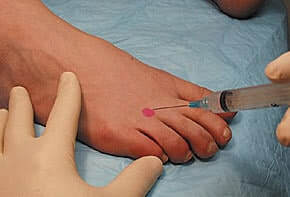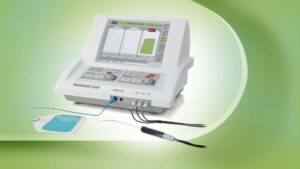Morton’s neuroma is a clinical condition characterized by pain in the foot. Typically, there is inflammation of the plantar inter-digital nerve and this can over time, have a significant impact on the patient’s mobility. Treatment options have varied in the management of Morton’s neuroma, starting with simple physiotherapy and leading to medical therapy in the form of orthotic devices and physical therapy and then to interventional procedures. Of course, in patients in whom conservative, medical treatment and interventional procedures have failed; surgical options may need to be considered. But the question that arises is how often does medical treatment and interventional procedures help patients with Morton’s neuroma? Is surgery an inevitable consequence of the condition?
Here we take a look at this aspect in a little more detail.
There are a number of conservative treatment options for Morton’s neuroma.
1. Orthotic devices
The use of orthotic devices has become an important step in the management of Morton’s neuroma. Orthotic devices are simple devices that fit in your shoes and alter the way the foot is positioned in order to reduce stress on a particular part of the foot. In patients with Morton’s neuroma, these devices are utilized to prevent compression of the inter-digital nerve and work by raising the head of the metatarsal bones in the foot.
2. Other modalities
In the event that orthotic devices are also not useful, physical therapists can offer more specialized non-surgical treatments such as ultrasound therapy, stretching exercises, and deep tissue massage. Correct physical therapy together with medication and modification of shoes are simple first steps. A well-trained physical therapist should provide an appropriate physical therapy program, which can be supplemented with simple off the shelf pain medications (if needed) and wear firm shoes that have a wide toe box and appropriate padding. These are effective treatment measures that can significantly reduce pain and improve clinical symptoms remarkably. If these, fail then other somewhat more aggressive conservative treatment options must be considered.
3. Corticosteroid injections

Another treatment option in addition to physical therapy that is available is the use of corticosteroid injections. Injection of steroids into the space where the plantar inter digital nerve is inflamed can reduce inflammation significantly and subsequently reduce pain.
Patients tend to find an enhancement in their mobility and an improvement in the quality of life, though this effect may be short lived.
Corticosteroid injections can be repeated butthefrequent use of multiple corticosteroids injections can have detrimental effects locally and within the body. However, combining corticosteroid injections with orthotic devices and physical therapy can be extremely beneficial in patients and many a time further treatment may not be required.
If the pain persists, however, there are other non-surgical procedures to treat Morton’s Neuroma.
1. Radiofrequency ablation
Radiofrequency ablation is a procedure that involves exposure of the affected part of the body to radiofrequency frequency waves. In Morton’s neuroma, the use of radiofrequency ablation has been well documented and proven to be beneficial.
The mechanism of action involves the use of heat to destroy the nerve fibers affected by Morton’s neuroma and the subsequent destruction of both the outer layer and the underlying nerve by heat. This results in a great deal of pain reduction and an improvement in mobility of patients.

5. Cryotherapy ablation
Cryotherapy is cold therapy. It involves exposure of the affected sheath of the nerve in Morton’s neuroma to extremely cold temperatures (up to -67 degree C), resulting in the freezing of the nerve fibers. The cold temperature destroys the outer layer (or sheath) of the nerve fibers, and part of the underlying nerve, which is responsible for conduction of pain impulses along the fiber. In essence, the treatment will result in a significant reduction of pain.
6. Neurolytic ablation
Neurolytic ablation is a procedure where an concentrated neurolytic agent is injected into the affected nerve. The commonly used sclerosing agent in managing Morton’s neuroma is alcohol. Neurolytic ablation is very effective in reducing pain and improving mobility.
There are no clear rules as to how many procedures are needed to treat your Morton’s neuroma, but here are some guidelines:
We do not have a cookie cutter approach to your care. Morton’s neuroma is difficult to treat, but we specialize in treating Morton’s neuroma and we have a number of solutions. So if you have come and see us and have an ultrasound guided procedure but still have pain, don’t be discouraged. We have a number of ultrasound guided procedures that we can do if one does not produce the results we expect. We will stick by you and work with you to treat your Morton’s neruoma. You may need multiple procedures.
We wait 6 weeks for the full effect of the procedure before we make a decision with you to do another procedure. If you need a repeat procedure, you can come in and have it done. In general, since you are already a patient of ours, your can come in, have your procedure and travel all on the same day. You do not need to come in for a separate evaluation visit, unless you would like to see us beforehand.
Depending on the results of your first procedure, we may repeat the same procedure or we may do a different ultrasound guided ablation procedure. If your response to our procedure has been below our expectations, we may also recommend a Platelet Rich Plasma injection done under ultrasound guidance in addition to your procedure.
There is no specific time when surgery is offered for Morton’s neuroma. However, if conservative treatment options have all been exhausted and the patient is continuing to experience symptoms, surgery is warranted. Morton’s neuroma surgery is often performed by an orthopedic surgeon and involves removal of the Mortons neuroma.
Morton’s neuroma is a painful condition that brings with it a great deal of disability and discomfort. There are a number of different conservative and medical treatment options and procedures available that can help control pain and enhance patient’s mobility. They can be, in fact, extremely effective. However, in a small number of patients, these conservative treatment options may not be of benefit. In such patients, surgery becomes a necessary in order to improve the quality of life.


By providing us with your information you are consenting to the collection and use of your information in accordance with our Terms of Service and Privacy Policy.